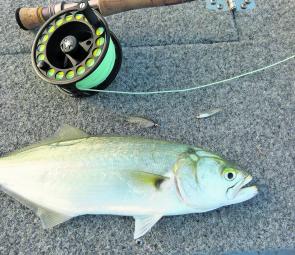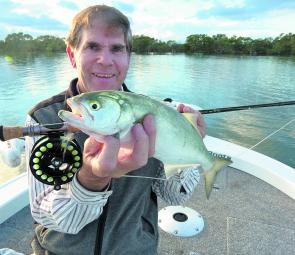Some people don’t enjoy winter. Too cold, blah blah. Me? I love it. There’s always a trip to some inland waterway on the cards, or fishing for bass in one of the big southern Queensland dams.
And then there’s chasing tailor on fly. It’s something that doesn’t happen in the warmer months at all, but it’s certainly a realistic proposition right now.
The best thing about chasing tailor on fly is that you don’t need a boat. There are plenty of places to tangle with a tailor without putting a boat in the water as these fish will feed very close to the shore. They push bait in against structure and hammer it so where there’s some close-in depth, white water or a bit of surge, tailor will feed virtually at your feet.
Canal estates all over southern Queensland have channels with rock walls and groynes at entrance areas where bait and tailor can be found congregating. River and creek mouths exiting cleanly into the ocean along the south Queensland and northern New South Wales coastline also feature rock walls where a fly cast into the white water will quickly bring a solid yank on the line followed by a decent bend in the fly rod.
Tailor don’t mess about with a fly and about the only downside comes from those razor-sharp teeth and strong jaws which require a small section of bite-off prevention leader tip as a safeguard. Tailor are not at all leader shy so a small section of 15kg hard line (I use FC100) at the end of the rod-length leader will not be an issue.
Tailor are strong fish but entirely clean fighters so there’s no need to go overboard with the likes of a 9wt or 10wt outfit. Let’s face it – most tailor taken will be choppers and an 8wt outfit will play out a fish quite efficiently. Also, as we are trying to imitate baitfish with our flies, there’s every likelihood that flies won’t be tied on hooks much larger than 2/0, so these flies should be easily cast with the 8wt as well.
Choice of fly rod comes down to quality. The better the quality the easier it is to cast. Throughout all of flyfishing nothing ever changes there.
When selecting a fly line for the job you have some flexibility. Either a floating or intermediate sink rate line will be fine. Tailor will hammer popper-style flies quite as readily as they attack a minnow or Deceiver type of fly so if a floating line is the one on hand you can use it quite readily for either surface work or sub-surface action where the fly is allowed to sink prior to the usual strip/stop retrieve.
The reel needs some serious thought. A reliable and smooth drag is a must. Also, this is definitely saltwater work and there could be some spray and wash about the place, so if the reel isn’t a dedicated salt water model the only option is to give it a thorough clean up after use. I believe all fly reels need a wash after saltwater use; it’s only common sense. However, a make-do freshwater one will need a more prolonged clean up which should also include the fly line. It’s a no brainer really.
I don’t see a real need for 300m of backing on a tailor outfit. If the fish can’t be turned within 100m it’s either a definite line class record tailor for the angler or a sneaky but large trevally has come into the fray unannounced. In my experience, 150m of 50lb braid backing is sufficient.
Flies for tailor need to have a general baitfish profile, which takes in a whole gamut of contenders from various Deceivers through to Clousers and Pink Things. Tailor are not choosy fish; they’re more opportunistic than selective. For this reason, as long as a fly looks generally like a baitfish it should be taken provided you don’t get too carried away with the retrieve and have the fly moving as quickly as if you were targeting mackerel or tuna. An exact imitation of a baitfish is fine if it’s convenient, but it’s certainly not mandatory.
Here’s another tip: although we think of tailor as surface ripping feeders they are not keen on things moving at supersonic speeds. A degree of stop/start in a retrieve will bring most hits.
If you’re fishing for tailor from the shore, there is one item that’s worth its weight in shining gold: the trusty stripping basket. Keeping the fly line free from tangles is important when trying for some cracker casts with perhaps rough going underfoot, or maybe a series of waves washing about and trying to grab the fly line.
Lastly, don’t be put off from flyfishing for tailor if you don’t have good success straight away. There’s usually a lot more going on below the surface of the water than above. Fishing just on first light or on dusk should pay dividends but it always comes down to having faith and making plenty of casts, retrieving in an enticing but not too fast manner, and keeping slack line out of the equation so that you can easily feel a bite and convert it to a fish on the rod.
Reads: 7587
The author’s flies are not fancy but they certainly work. Note the fly tied well back on the hook to prevent bite-offs.

Small baitfish, small fly, nice chopper.

While the author took this chopper from his boat a lot of tailor can be taken from land-based locations as well.




